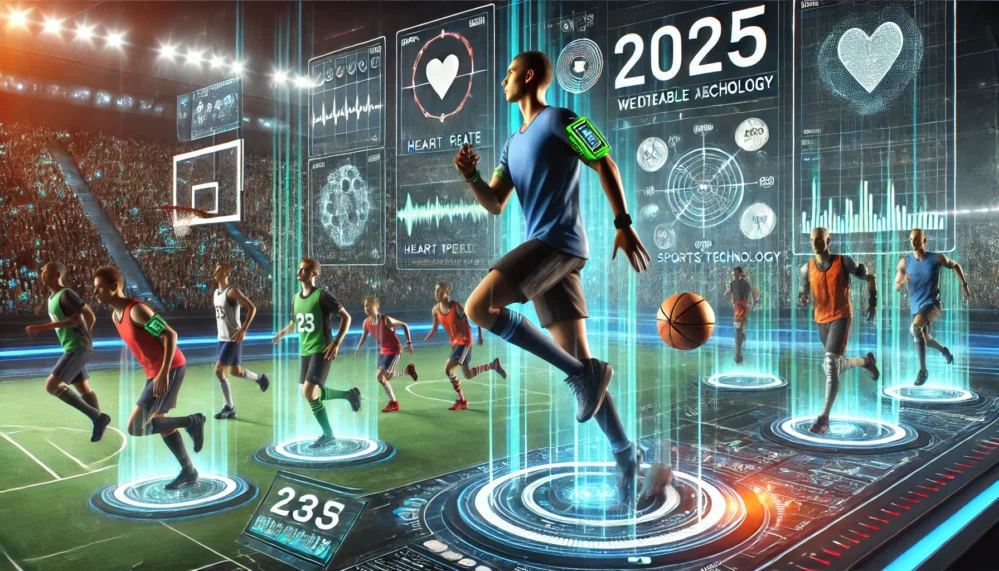
Imagine a future where every stride, jump, and heartbeat on the field is captured by tiny, almost magical sensors—ushering in a new era of athletic performance. Welcome to the wearable analytics revolution in sports, where real-time data fuels performance optimization like never before.
The Pulse of Modern Sports: Wearable Analytics Unveiled
In the rapidly evolving world of professional sports, wearable analytics have stepped into the spotlight. These smart devices—embedded in uniforms, shoes, or even directly attached to the skin—are not just tracking steps but are deciphering complex patterns that help athletes fine-tune their training regimens and recovery plans. By transmitting data on heart rates, muscle strain, and even sweat composition, these gadgets transform raw numbers into actionable insights, all in real time.
This technological leap has been both celebrated and critiqued. On one hand, teams are ecstatic about how these wearables provide unprecedented precision in performance monitoring. On the other, critics question data privacy and the overwhelming reliance on technology—a debate that has even captured the attention of government regulators and political pundits.
Government Insights and Political Dialogues
Government bodies around the world are beginning to take notice. Recent initiatives by sports ministries and health agencies in several countries have aimed to standardize the use of wearable analytics to ensure data security and ethical use. For instance, the U.S. Department of Health and Human Services recently released guidelines outlining the protection of biometric data in sports, while European regulators have hinted at similar frameworks. These measures are designed to prevent misuse of personal data while encouraging innovation.
Politically, the conversation is as heated as a championship final. Politicians from various parties have taken differing stances: some champion the benefits of these advancements for national sports development and public health, whereas others caution about potential overreach and privacy infringements. Amid this political tug-of-war, it’s clear that wearable analytics are more than just a tech trend—they’re a topic at the intersection of innovation, ethics, and governance.
Scientific Research and Breakthroughs in Wearable Tech
The backbone of this revolution is cutting-edge research conducted by top-tier laboratories and universities. Renowned institutions such as MIT and Stanford, along with dedicated research labs worldwide, are pioneering studies that integrate biomechanics, AI, and sensor technology to create even more sophisticated wearable devices. One standout project, for example, involves developing sensors that not only capture physical exertion but also predict injury risks based on muscle fatigue and recovery patterns. Learn more about this breakthrough research.
Leading scientists, who often resemble modern-day alchemists, mix data with intuition. Their experiments, sometimes conducted in unconventional settings like high-altitude training camps, are redefining what athletes know about their own bodies. One researcher from a prominent European institute commented, “We are only scratching the surface of what real-time data can reveal about human performance.” This blend of scientific inquiry and athletic prowess continues to push the boundaries of what’s possible in sports.
Celebrity Endorsements and Athlete Perspectives
It’s not just the scientists and government officials who are buzzing with excitement—celebrities and top athletes are also weighing in on the phenomenon. Sporting icons, whose names are synonymous with excellence, have publicly praised wearable analytics for providing the competitive edge that makes champions. For instance, a famous basketball star once remarked in an exclusive interview, “When you have a device that tells you exactly when to push harder or ease off, you’re essentially unlocking the blueprint to your own performance.” Such endorsements lend credibility and a cool factor to the technology, making it a must-have in every athlete’s toolkit.
However, the opinions among athletes aren’t entirely uniform. Some veterans, having relied on instinct and traditional training methods for decades, express reservations. “In my day, we trusted our gut more than any gadget,” an older coach might say, reflecting a nostalgia for simpler times. This sentiment creates a fascinating dialogue between generations, highlighting both the promise of innovation and the comfort of tradition.
The Youthful Excitement: A New Era of Sports Fandom
For the younger generation, wearable analytics represent nothing short of a revolution. Young athletes and fans, growing up in a digital age, view these devices as indispensable tools for personal and team success. Social media buzzes with clips of athletes checking their real-time stats mid-game, and there’s an unmistakable thrill in knowing that every movement is being analyzed to perfection. Many young players even experiment with these analytics in their own training, seeking to emulate the pros and gain that elusive competitive advantage.
This digital native cohort not only embraces technology but also advocates for its continuous evolution. They are quick to adopt new features, share hacks, and demand even more transparency from device manufacturers. Their enthusiasm is contagious, igniting a fresh wave of innovation that continuously propels wearable tech into uncharted territories.
Global Business, Earnings, and Revenue Growth
Behind the scenes of the athletic arena lies a booming global business. Companies specializing in wearable technology are witnessing astronomical growth, with projections for the market soaring into the tens of billions by 2025. Major players like Apple, Samsung, and emerging startups alike are investing heavily in R&D, ensuring that their devices not only measure performance but also integrate seamlessly with digital ecosystems and smart stadiums.
The financial landscape is as dynamic as the technology itself. Recent reports indicate that global revenue from wearable sports analytics is not just growing—it’s exploding. Investors are pouring capital into startups that focus on niche aspects of performance data, from sleep analytics to nutritional tracking. This influx of investment is fostering an environment of rapid innovation and fierce competition, driving both quality and affordability to new heights.
Moreover, many governments are starting to see economic benefits too. Grants and subsidies for tech startups focusing on health and sports analytics have surged, spurring job creation and technological advancements that ripple across other sectors. As these technologies permeate global markets, the resulting economic boom is set to redefine the landscape of both sports and business.
Real-Time Data in Action: Case Studies from the Field
When we talk about wearable analytics, it’s hard not to mention the transformative impact on major sports teams. Take, for example, a top-tier football club that has integrated wearable devices into its daily training regimen. These devices provide coaches with minute-by-minute updates on player performance, allowing for tailored workouts and injury prevention strategies. This data-driven approach has led to measurable improvements in speed, agility, and overall team synergy.
Similarly, in basketball, wearables are used to track player movements during high-intensity games. This allows teams to refine their defensive strategies by analyzing patterns in player positioning and fatigue levels. Read more about innovative sports strategies here. Even sports like cycling and tennis are reaping the benefits, with athletes fine-tuning their performance based on insights gleaned from wearable data.
Challenges and Controversies: The Flip Side of Innovation
Yet, as with any disruptive technology, there are challenges. Data privacy is a recurring concern. With so much personal information being transmitted and stored, the risk of data breaches or misuse looms large. Critics argue that while the benefits are immense, there is an urgent need for robust regulatory frameworks to protect athletes’ privacy. Some athletes worry that their personal data might be exploited by sponsors or even rival teams, creating an uneven playing field.
Moreover, there is an inherent tension between tradition and technology. Older generations in sports, who have long relied on gut instinct and experience, sometimes view the influx of data as undermining the human element of athletic performance. “Technology should support, not replace, the wisdom gained over years of playing the game,” a seasoned coach might lament. These voices remind us that while wearable analytics open up exciting possibilities, they also require careful, ethical integration into the sports ecosystem.
Social and Cultural Reflections
The societal impact of wearable analytics extends far beyond the confines of the playing field. In many ways, these devices are reshaping how we perceive health, fitness, and human potential. Social media platforms are awash with stories of personal transformation, as everyday people adopt wearables to track their fitness journeys, improve their health, and even recover from injuries.
For older individuals, wearable technology offers a new way to stay connected with their passions. Retired athletes and fans alike now have the opportunity to engage with sports on a more interactive level. There’s a bittersweet charm in seeing technology bridge generational gaps, even as it sometimes leaves the older generation wondering if the magic of the game is slowly being digitized away.
On the flip side, for many young enthusiasts, these innovations are the very embodiment of progress. They see wearable analytics as a symbol of how far technology has come—and how it can be leveraged to enhance not just professional sports but everyday fitness. This diversity in perspectives creates a rich tapestry of opinions, each adding its own shade to the vibrant picture of modern sports culture.
The Future is Now: Looking Ahead to 2025
As we stand on the cusp of 2025, the future of wearable analytics in sports looks nothing short of revolutionary. Imagine a world where augmented reality glasses display your real-time stats during a game, or where AI coaches use data from wearable devices to craft personalized training regimens down to the millisecond. The lines between physical performance and digital augmentation are becoming increasingly blurred.
Futuristic innovations promise not only to enhance performance but also to redefine the very nature of sports. We could soon witness fully immersive training environments where virtual simulations, powered by real-time data, allow athletes to practice in a controlled yet dynamically changing environment. This level of integration between technology and athleticism is both exhilarating and a bit disconcerting—a testament to how rapidly our world is evolving.
Bridging the Gap: Integrating Technology and Tradition
It’s important to recognize that while the future is undoubtedly digital, the essence of sports remains deeply human. Coaches and athletes are learning to balance the insights provided by wearable analytics with the intangible qualities of intuition, experience, and passion. Many teams are now fostering a culture where technology serves as a guide rather than a dictator—a tool that augments the human spirit rather than overshadowing it.
This delicate balancing act is evident across various sports disciplines. In football, for example, data is used to inform tactical decisions, but it’s the raw instinct of the players that ultimately makes the difference in those crucial moments. The conversation between data scientists and coaches often takes on a philosophical tone, as they debate how best to integrate numbers with human judgment—a dialogue that, much like a well-fought game, is full of unexpected twists and turns.
Global Business and Economic Impacts
Beyond the field, the business landscape surrounding wearable analytics is booming. Major tech giants and innovative startups alike are betting big on the future of this technology. Markets are being redefined as companies invest in advanced sensors, cloud computing, and AI-driven analytics platforms to stay ahead of the curve. The global revenue generated by wearable sports technology is predicted to climb exponentially, fueled by demand from professional sports leagues, fitness enthusiasts, and health-conscious consumers.
Investors, too, are taking note. Funding rounds for companies specializing in wearable tech have soared, with venture capital pouring in like confetti at a championship celebration. This influx of capital not only drives innovation but also creates a ripple effect throughout the global economy—generating jobs, fostering new industries, and even influencing public policy. Governments are beginning to view wearable technology not merely as a tool for sports but as a critical driver of economic growth and technological advancement on a global scale.
External Links for Further Reading
Additionally, for authoritative insights on government regulations and tech innovations, visit GovInfo and TechCrunch.
A Mosaic of Perspectives: Voices from Every Generation
In this swirling mix of high-tech innovation and raw human passion, opinions vary widely. Older sports veterans often recall a time when grit and determination were the sole metrics of success, sometimes questioning if too much reliance on data might strip away the soul of the game. Meanwhile, young athletes embrace every new sensor and stat, seeing them as stepping stones to unprecedented personal growth and competitive brilliance.
This mosaic of opinions—spanning seasoned coaches, tech-savvy youngsters, and everyone in between—highlights an essential truth: while technology is reshaping sports, the spirit of competition remains timeless. Whether you’re skeptical of the digital takeover or eagerly awaiting the next big breakthrough, there’s no denying that wearable analytics are here to stay, weaving together the threads of tradition and innovation into a complex, ever-evolving tapestry.
Challenges That Demand Our Attention
As with every monumental shift, the integration of wearable analytics comes with its fair share of hurdles. Beyond privacy concerns, there are practical challenges such as device durability, data accuracy, and the potential for technology to inadvertently create disparities between teams with different financial capabilities. There’s also the human element—where trust in one’s instincts and experience sometimes clashes with cold, hard data.
These challenges, though significant, are not insurmountable. They serve as catalysts for continuous improvement, prompting collaborations between tech companies, sports organizations, and regulatory bodies. In this way, the evolution of wearable analytics is not a straight path but rather a winding road filled with learning curves, unexpected detours, and, occasionally, even delightful surprises.
Navigating Ethical and Regulatory Waters
Ethics in sports technology is a subject that demands both scrutiny and sensitivity. The burgeoning reliance on data brings with it ethical dilemmas that extend far beyond the playing field. How much data is too much? Who has the right to access this information? And can we ensure that the competitive advantages afforded by wearable analytics are distributed fairly across all levels of sport?
Regulatory frameworks are being developed to answer these very questions. Countries are at different stages of implementing laws that govern the collection, storage, and use of biometric data. While some nations have swiftly embraced the technology with robust guidelines, others are still grappling with the implications. This patchwork of policies underscores the need for global dialogue and cooperative regulation, ensuring that the benefits of wearable analytics are enjoyed by all, without compromising individual rights.
Embracing the Complexity: A Human-Centric Approach
The journey of wearable analytics is as much about numbers as it is about people. It’s about understanding that every data point represents a human being with dreams, aspirations, and a unique story. This human-centric approach is what sets the true champions apart—those who can harness technology without losing sight of the human spirit that makes sports so compelling.
Anecdotes from the field often paint a vivid picture: an athlete who, after months of battling recurring injuries, finds renewed hope through the detailed feedback from a wearable device; a coach who rediscovers the joy of mentoring when technology helps tailor training sessions to each player’s specific needs. These stories, though varied and sometimes contradictory, remind us that at its core, the wearable analytics revolution is about empowering individuals and enhancing the very essence of human performance.
Final Thoughts and a Call to Action
As we navigate this brave new world of wearable analytics, it’s clear that the journey has only just begun. The technology, with all its promise and challenges, is set to redefine professional sports and the broader landscape of health and performance. Whether you’re a tech enthusiast, a sports fanatic, or someone who simply appreciates the blend of art and science, now is the time to get involved, learn more, and be part of this exciting transformation.
So, what’s next for you? Perhaps it’s time to explore how wearable analytics can enhance your own training or simply to follow the latest trends in sports innovation. Dive deeper into our other articles on emerging sports technologies, or join our community newsletter to stay updated on the latest breakthroughs and regulatory updates. The future of sports is here—dynamic, data-driven, and daringly human.
Frequently Asked Questions (FAQs)
Q1: What exactly is wearable analytics in sports?
A: Wearable analytics involves using smart devices to collect real-time data on various aspects of athletic performance—like heart rate, speed, and muscle activity—to help optimize training and prevent injuries.
Q2: How is the government involved in regulating wearable tech in sports?
A: Governments worldwide are implementing guidelines and regulations to ensure data privacy and ethical use of biometric information, balancing innovation with individual rights.
Q3: Are there any risks associated with relying too heavily on wearable analytics?
A: Yes, concerns include data security, privacy issues, and the potential for over-reliance on technology, which might undermine traditional coaching and athlete intuition.
Q4: How do athletes from different generations view wearable analytics?
A: Younger athletes are generally more enthusiastic and quick to adopt these technologies, while older athletes and coaches often prefer traditional methods and express concerns about over-digitalization.
Q5: What impact is wearable analytics expected to have on global business?
A: The wearable tech market is booming, with significant investments fueling innovation, creating new revenue streams, and influencing economic policies across nations.
In a world where innovation meets athletic excellence, the wearable analytics revolution continues to redefine what it means to be a champion. Whether you’re tracking your personal fitness journey or following the latest developments in professional sports, remember: every data point tells a story, and every story fuels the drive to be better. Embrace the future of sports, where technology and humanity intersect to create extraordinary possibilities.
Explore more on our sports innovation hub and join the conversation about how wearable analytics are shaping the future of athletic performance.



